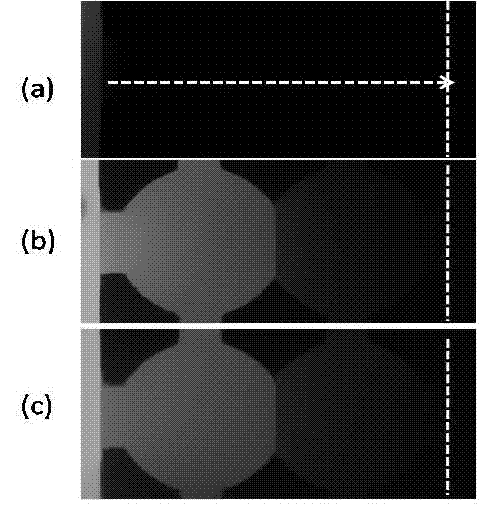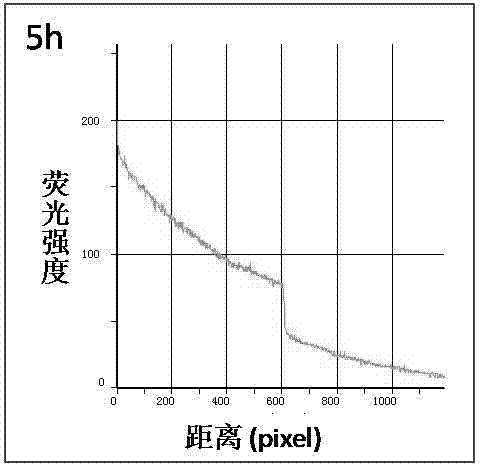Micro-fluidic chip capable of producing stable concentration gradient and cell co-culture method
A microfluidic chip and concentration gradient technology, applied in the field of biomedical research, can solve the problems of large amount of cells, large consumption of reagents, lack of biological information, etc., and achieve important biomedical research value and economic value, sample amount Few, easy-to-use effects
- Summary
- Abstract
- Description
- Claims
- Application Information
AI Technical Summary
Problems solved by technology
Method used
Image
Examples
Embodiment 1
[0021] The microfluidic chip used was designed and manufactured by our laboratory. The chip is formed by irreversible sealing of upper and lower layers, the upper layer material is PDMS polymer, and the lower layer material is glass. Such as figure 1 As shown, the size of the perfusion channel is 10 mm in length, 500 μm in width, and 200-300 μm in height (the black area in the figure), the size of the culture chamber A is 1 mm in diameter, and 120 μm in height (the gray area in the figure), and the culture chamber B The dimensions are 1 mm in diameter and 50 μm in height (light gray area in the figure). Take 5 μl of three-dimensional Matrigel with a pipette, add it to culture chambers B and A sequentially through the sample inlet pool, and place them in a 37°C incubator for 20-30 min. After gelling, the culture solution containing FITC-dextran and the culture solution without fluorescent dye were added to the perfusion channels A and B respectively, and the continuous perfus...
Embodiment 2
[0024] Cell contact co-culture: including four parts: live cell labeling, cell loading, cell chip co-culture and photo detection. First, CellTracker Red and CellTracker Green were used to stain salivary adenoid cystic carcinoma cells ACCM and mesenchymal stem cells MSCs, respectively, with a final concentration of 5 μM. After the staining was completed, the cells were digested, and the mixture of salivary adenoid cystic carcinoma cells ACCM and matrigel was added to the culture chamber B through the sample inlet pool B, and placed in CO 2 In the incubator; after gelling for 20-30 min, add mesenchymal stem cells MSCs into the culture chamber A through the sample inlet pool A; place in CO 2 In the incubator; after gelling for 20-30 min, add cell culture medium into perfusion channels A and B, and replace the cell culture medium once a day. Photographs were taken at 0 h, 24 h, and 48 h to record the location of the cells, and the initial intersection of the two cells was taken a...
Embodiment 3
[0026] Directed migration of tumor cells: including live cell labeling, cell loading, cell chip culture, generation of chemokine concentration gradients, and cell photography. First, CellTracker Red was used to stain salivary adenoid cystic carcinoma cells ACCM in vivo, and the final concentration was 5 μM. After staining, proceed to cell digestion. Salivary gland adenoid cystic carcinoma cells ACCM were mixed in matrigel three-dimensional matrigel, and the mixture of cells and matrigel was added through the sample inlet pool B, and placed in CO 2 In the incubator, after 20-30 minutes of gelation, add matrigel without any cells through the sample inlet pool A. After 20-30 minutes of gelation, a clear interface between the gel and cells can be formed, and then the perfusion is performed through the syringe pump. Channels A and B respectively introduce the culture solution containing chemokines and the culture solution not containing chemokines, and ensure continuous perfusion ...
PUM
 Login to View More
Login to View More Abstract
Description
Claims
Application Information
 Login to View More
Login to View More - R&D Engineer
- R&D Manager
- IP Professional
- Industry Leading Data Capabilities
- Powerful AI technology
- Patent DNA Extraction
Browse by: Latest US Patents, China's latest patents, Technical Efficacy Thesaurus, Application Domain, Technology Topic, Popular Technical Reports.
© 2024 PatSnap. All rights reserved.Legal|Privacy policy|Modern Slavery Act Transparency Statement|Sitemap|About US| Contact US: help@patsnap.com










